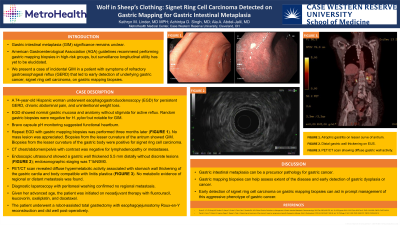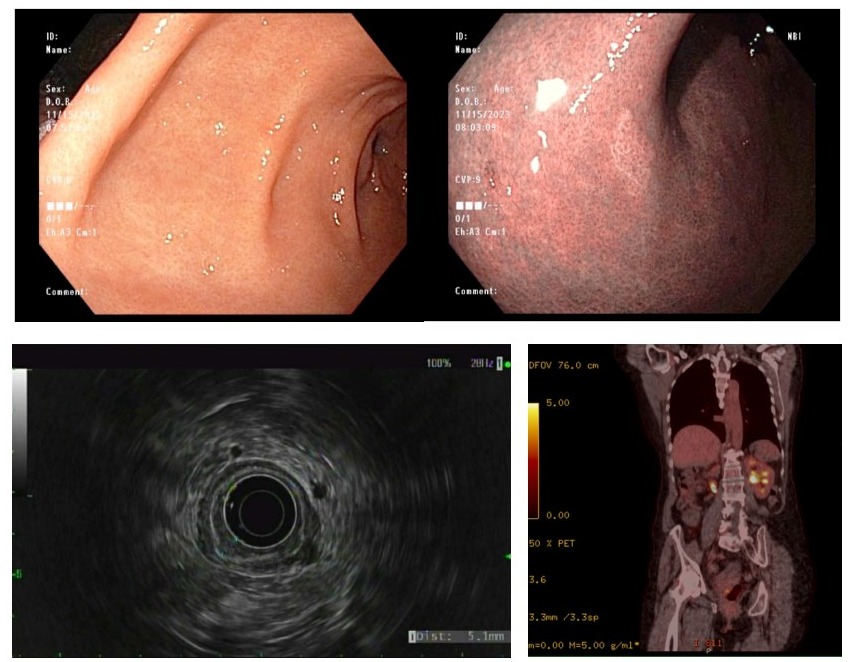Sunday Poster Session
Category: Stomach
P1648 - Wolf in Sheep’s Clothing: Signet Ring Cell Carcinoma Detected on Gastric Mapping for Gastric Intestinal Metaplasia
Sunday, October 27, 2024
3:30 PM - 7:00 PM ET
Location: Exhibit Hall E

Has Audio

Kathryn M. Linder, MD, MPH
Case Western Reserve University / MetroHealth
Cleveland, OH
Presenting Author(s)
Kathryn M. Linder, MD, MPH, Achintya D.. Singh, MBBS, MD
Case Western Reserve University / MetroHealth, Cleveland, OH
Introduction: The follow-up management of incidentally diagnosed gastric intestinal metaplasia (GIM) remains unclear. The present American Gastroenterological Association guidelines recommend gastric mapping for high-risk groups but the longitudinal utility of these repeat procedures has yet to be elucidated. We present a case of incidental GIM in a patient with symptoms of refractory gastroesophageal reflux (GERD) that led to early detection of underlying gastric cancer on gastric mapping.
Case Description/Methods: A 74-year-old Hispanic woman underwent esophagogastroduodenoscopy (EGD) for evaluation of symptoms of refractory GERD and unintentional weight loss. The EGD showed normal gastric mucosa and anatomy with no stigmata for active reflux. Random gastric biopsies were negative for H. pylori but notable for GIM without dysplasia. Results of concurrent Bravo capsule pH monitoring suggested functional heartburn. A shared decision was reached with the patient to repeat a diagnostic EGD and gastric mapping to assess the extent of GIM (Figure 1). Endoscopic evaluation was negative for any mass lesions but the biopsies from the body lesser curvature were, in fact, positive for signet ring cell carcinoma. Further, CT of the abdomen and pelvis did not show any lymphadenopathy or metastatic lesions. On the endoscopic ultrasound, the distal gastric wall was thickened to 5.5 mm without any discrete lesions (Figure 2), and the endosonographic staging was T1bN0M0. PET/CT revealed diffuse hypermetabolic activity with associated stomach wall thickening of the gastric cardia and body compatible with linitis plastica (Figure 3). No metabolic evidence of regional or distant metastasis was found. After a tumor board discussion the patient underwent a diagnostic laparoscopy with peritoneal washing that confirmed the absence of regional metastasis. Given her advanced age, the patient was initiated on neoadjuvant therapy with fluorouracil, leucovorin, oxaliplatin, and docetaxel. She recently underwent a robot-assisted total gastrectomy with esophagojejunostomy Roux-en-Y reconstruction and is improving post procedure.
Discussion: Gastric intestinal metaplasia can be a precursor pathology for gastric cancer. While the clinical significance of such findings is not well-established in western countries, gastric mapping may provide an opportunity for further detailed evaluation of the stomach. In unusual cases, such as this, it may aid in early detection of gastric cancer.

Disclosures:
Kathryn M. Linder, MD, MPH, Achintya D.. Singh, MBBS, MD. P1648 - Wolf in Sheep’s Clothing: Signet Ring Cell Carcinoma Detected on Gastric Mapping for Gastric Intestinal Metaplasia, ACG 2024 Annual Scientific Meeting Abstracts. Philadelphia, PA: American College of Gastroenterology.
Case Western Reserve University / MetroHealth, Cleveland, OH
Introduction: The follow-up management of incidentally diagnosed gastric intestinal metaplasia (GIM) remains unclear. The present American Gastroenterological Association guidelines recommend gastric mapping for high-risk groups but the longitudinal utility of these repeat procedures has yet to be elucidated. We present a case of incidental GIM in a patient with symptoms of refractory gastroesophageal reflux (GERD) that led to early detection of underlying gastric cancer on gastric mapping.
Case Description/Methods: A 74-year-old Hispanic woman underwent esophagogastroduodenoscopy (EGD) for evaluation of symptoms of refractory GERD and unintentional weight loss. The EGD showed normal gastric mucosa and anatomy with no stigmata for active reflux. Random gastric biopsies were negative for H. pylori but notable for GIM without dysplasia. Results of concurrent Bravo capsule pH monitoring suggested functional heartburn. A shared decision was reached with the patient to repeat a diagnostic EGD and gastric mapping to assess the extent of GIM (Figure 1). Endoscopic evaluation was negative for any mass lesions but the biopsies from the body lesser curvature were, in fact, positive for signet ring cell carcinoma. Further, CT of the abdomen and pelvis did not show any lymphadenopathy or metastatic lesions. On the endoscopic ultrasound, the distal gastric wall was thickened to 5.5 mm without any discrete lesions (Figure 2), and the endosonographic staging was T1bN0M0. PET/CT revealed diffuse hypermetabolic activity with associated stomach wall thickening of the gastric cardia and body compatible with linitis plastica (Figure 3). No metabolic evidence of regional or distant metastasis was found. After a tumor board discussion the patient underwent a diagnostic laparoscopy with peritoneal washing that confirmed the absence of regional metastasis. Given her advanced age, the patient was initiated on neoadjuvant therapy with fluorouracil, leucovorin, oxaliplatin, and docetaxel. She recently underwent a robot-assisted total gastrectomy with esophagojejunostomy Roux-en-Y reconstruction and is improving post procedure.
Discussion: Gastric intestinal metaplasia can be a precursor pathology for gastric cancer. While the clinical significance of such findings is not well-established in western countries, gastric mapping may provide an opportunity for further detailed evaluation of the stomach. In unusual cases, such as this, it may aid in early detection of gastric cancer.

Figure: Figure 1 (top) - Gastric mapping study.
Figure 2 (bottom, left) - EUS, distal gastric wall.
Figure 3 (bottom, right) - PET/CT.
Figure 2 (bottom, left) - EUS, distal gastric wall.
Figure 3 (bottom, right) - PET/CT.
Disclosures:
Kathryn Linder indicated no relevant financial relationships.
Achintya Singh indicated no relevant financial relationships.
Kathryn M. Linder, MD, MPH, Achintya D.. Singh, MBBS, MD. P1648 - Wolf in Sheep’s Clothing: Signet Ring Cell Carcinoma Detected on Gastric Mapping for Gastric Intestinal Metaplasia, ACG 2024 Annual Scientific Meeting Abstracts. Philadelphia, PA: American College of Gastroenterology.
